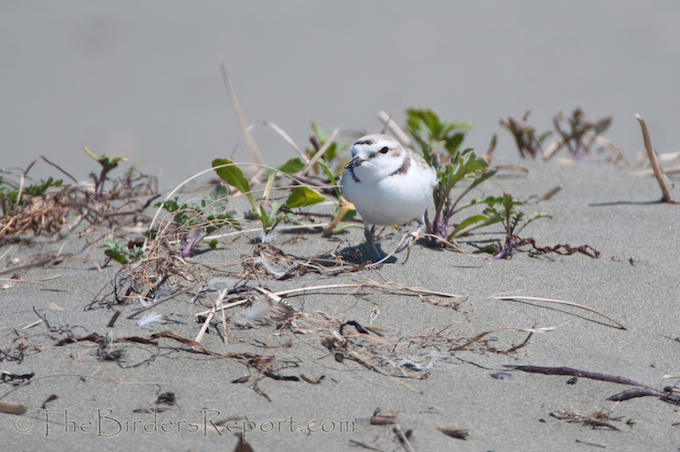 Pacific Coast Western Snowy Plover (Charadrius nivosus nivosus) Female photos by Larry Jordan
Pacific Coast Western Snowy Plover (Charadrius nivosus nivosus) Female photos by Larry Jordan
The Pacific Coast population of the Western Snowy Plover (Charadrius nivosus nivosus) is federally listed under the Endangered Species Act of 1973 as threatened. They are a Bird Species of Special Concern in California and were listed as endangered under the Washington Department of Game Policy No. 402 in 1981, and as threatened by the Oregon Fish and Wildlife Commission in 1975. The threatened status in Oregon was reaffirmed in 1989 under the Oregon Endangered Species Act1.
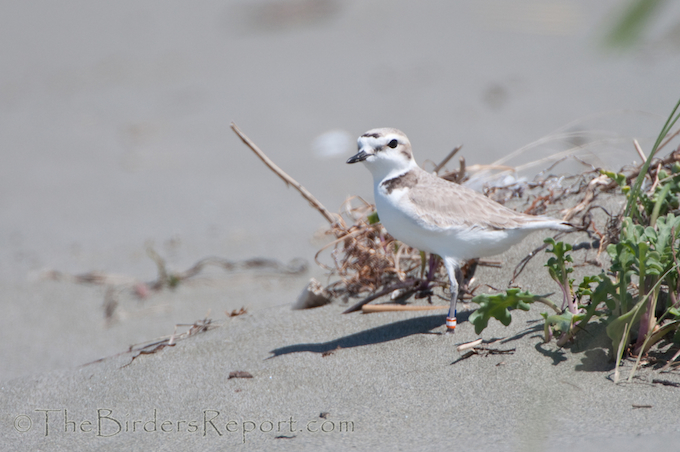 Western Snowy Plover (Charadrius nivosus nivosus) Female on Alert (click photos for full sized images)
Western Snowy Plover (Charadrius nivosus nivosus) Female on Alert (click photos for full sized images)
In June of 2012, the US Fish & Wildlife Service (FWS) designated approximately 24,527 acres of dune ecosystem habitat along the Pacific Coast essential to the survival and recovery of the plover. The Pacific Coast Western Snowy Plover nest on the mainland coast, peninsulas, offshore islands, bays, estuaries, salt ponds, and rivers of the Pacific Coast from southern Washington to southern Baja California, Mexico. They are distinct from Western Snowy Plovers that breed inland2.
Designated critical habitat includes unique and increasingly rare coastal beach-dune ecosystem habitat along the Pacific Coast essential to the survival and recovery of the plover. A total of 47 units have been designated in California, nine in Oregon, and four in Washington. Below are the designated area maps for Northern and Southern California.
This is what the habitat looked like at Clam Beach where I took these photos. Note the tall grasses on the dunes in the upper right side of the photo. This is one of the most significant causes of habitat loss for coastal breeding Western Snowy Plovers, the encroachment of introduced European beachgrass (Ammophila arenaria) and American beachgrass (Ammophila breviligulata). Introduced beachgrass contributes to habitat loss by reducing the amount of open, sandy habitat, steepening the beaches, and increasing habitat for predators.
The sparsely covered sandy area in the photo above has had the beachgrass removed and is roped off with signage to help protect the plover’s breeding grounds. With miles of beaches open to the public, this small area (about the size of a football field) seemed like an insignificantly small contribution to the conservation of this threatened species.
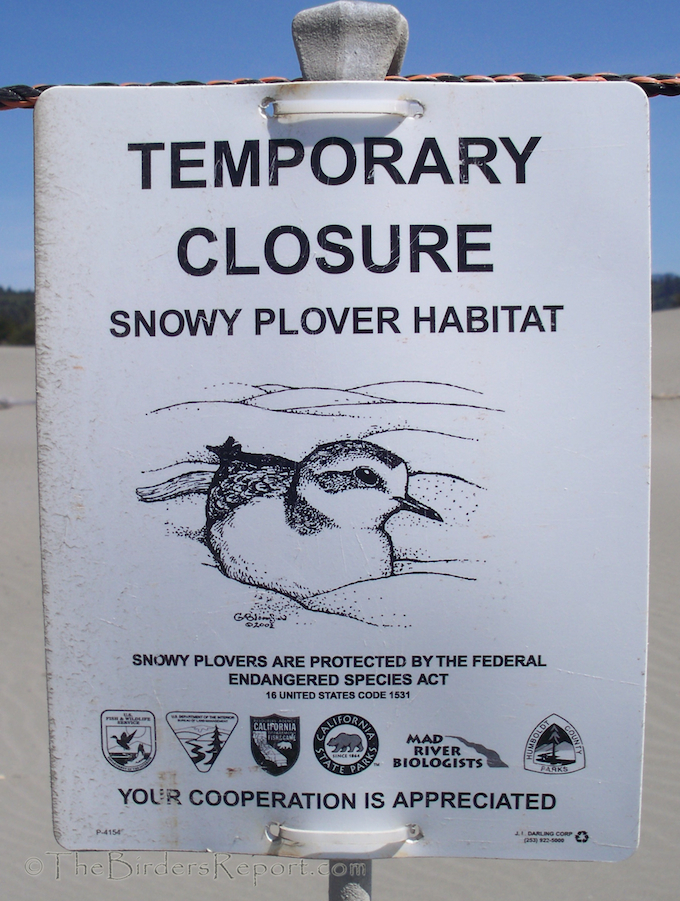
It took me awhile to find this section of beach where I was hoping to spot some Western Snowy Plovers. At the Godwit Days Spring Migration Bird Festival I had signed up for a trip to the South Spit of Humboldt Bay hoping to see some of these threatened birds but the excursion only took us to a the location of a Snowy Plover restoration area which had not actually been occupied yet. On that trip I met Drew who was also hoping to find the elusive plover. We made plans to meet at Clam Beach where I was told the Western Snowy Plover could be found.
We walked a long way before spotting the roped off area. Once we found it we surveyed the area (from outside the ropes of course). I was thinking we’d be lucky to spot one of the birds way out in the middle of the sandy landscape, but alas, I spotted one within thirty feet of the ropes! He was laying quietly atop one of the sand dunes. Drew and I were so excited to find our quarry that we both took several photos of our first sighting from all angles.
As we retreated from that location, we almost literally stumbled upon a pair of Western Snowy Plovers that were roaming outside of the roped off area. The photo of the male above and this female below are the pair that we cautiously photographed to our hearts content.
I’m not sure what they were doing but they walked among the small sand hills, unprotected on the open beach as we observed from a safe distance.
The female following the male with no obvious purpose that I could discern. According to Birds of North America Online, Pacific Coast Western Snowy Plovers begin egg laying in Humboldt County in March. They typically lay 3 eggs during all hours of the day and night with an average interval of 60 hours between eggs.
During this egg laying period, the adults may be away from their territory for more than a third of daylight hours3, so maybe this pair was simply resting.
Once they begin incubation, after the last egg is laid, both parents incubate the eggs, the female during the day and the male at night. The chicks hatch about 30 days later. They are precocial and leave the nest usually within one to three hours after hatching.
The wind was blowing pretty good and they would occasionally close their eyes to avoid the sand storm.
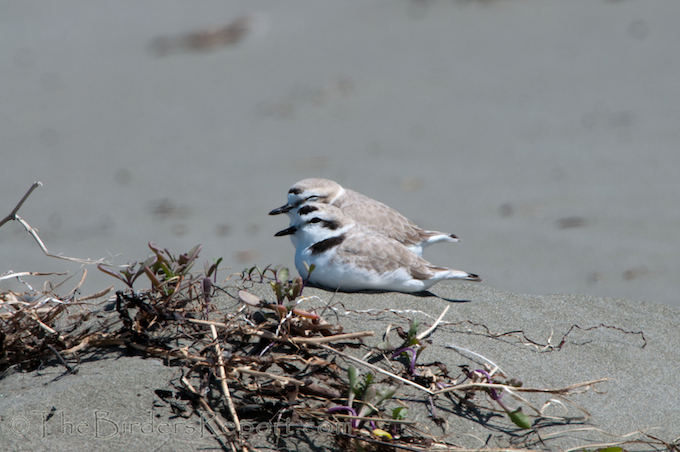
At one point, an off leash dog came running toward the birds unintentionally, not even seeing them, as the female plover stood up in an alert pose (top). We quickly chased that dog off as his owners casually strode along the beach several hundred yards away.
This is another huge problem for these little shorebirds, sharing the beaches with humans and off-leash dogs.
This guy however was comfortable enough to stop and preen as his mate looked on.
References: 1US Fish & Wildlife Service (FWS) Arcata Office, 2US Fish & Wildlife Service, 3Birds of North America Online

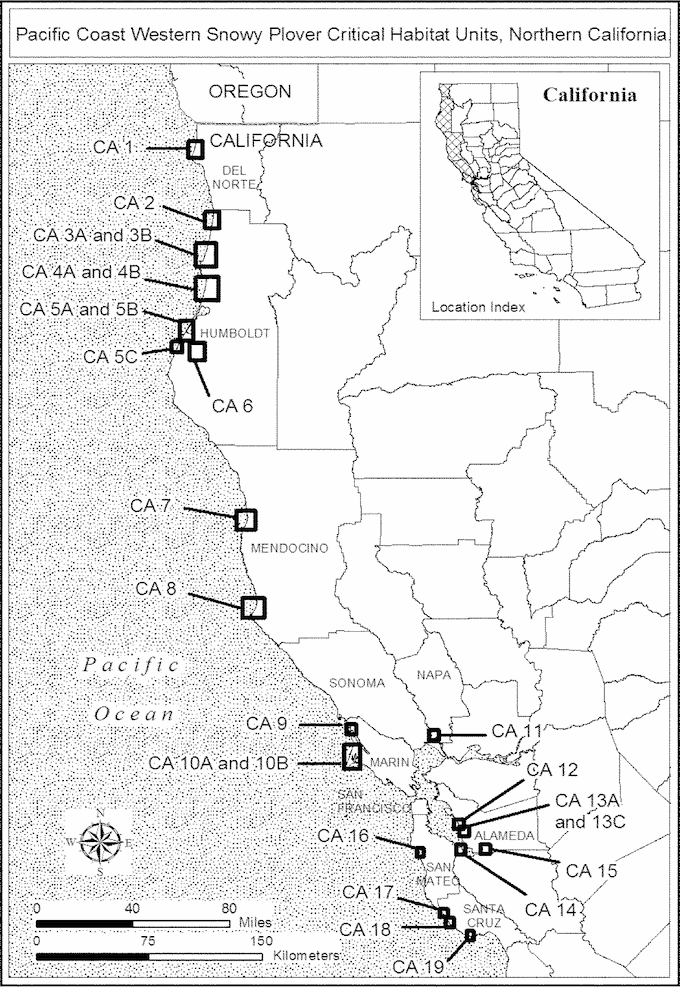
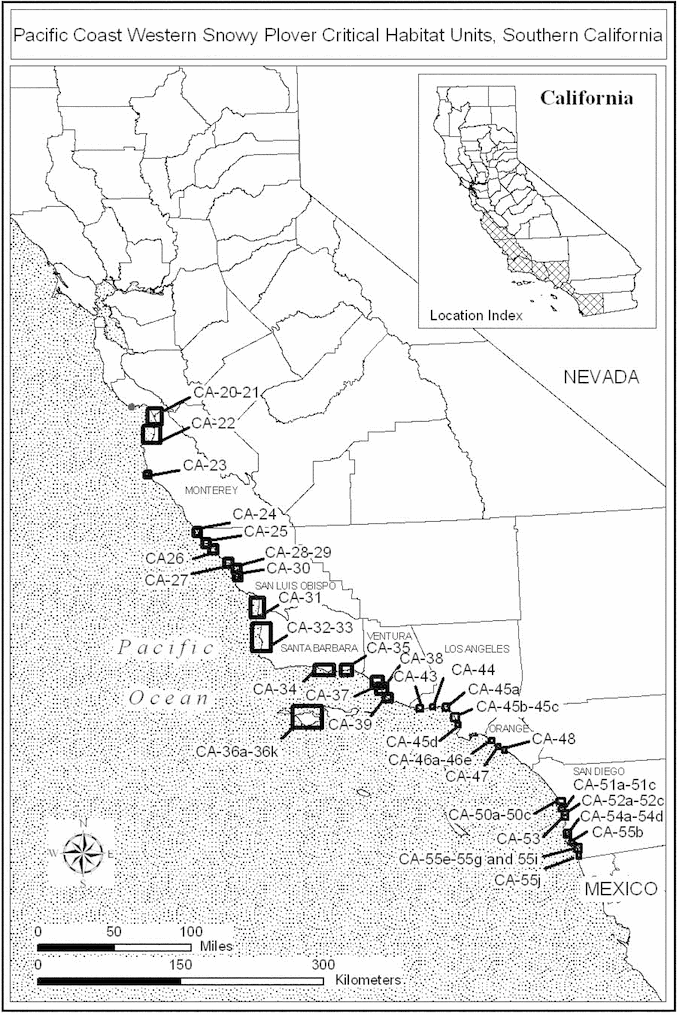
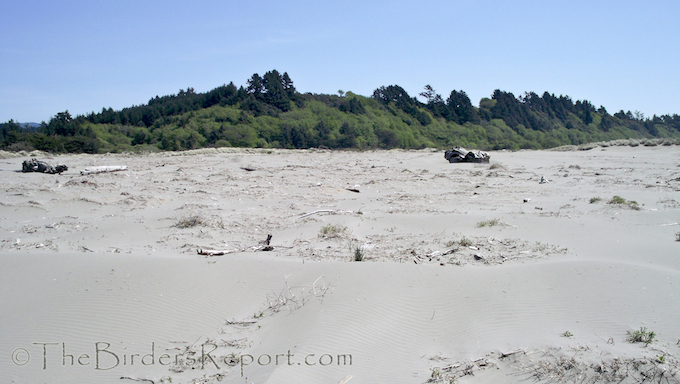
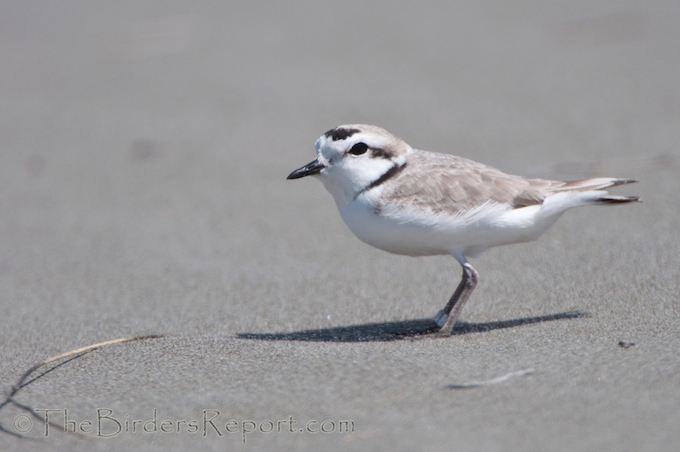
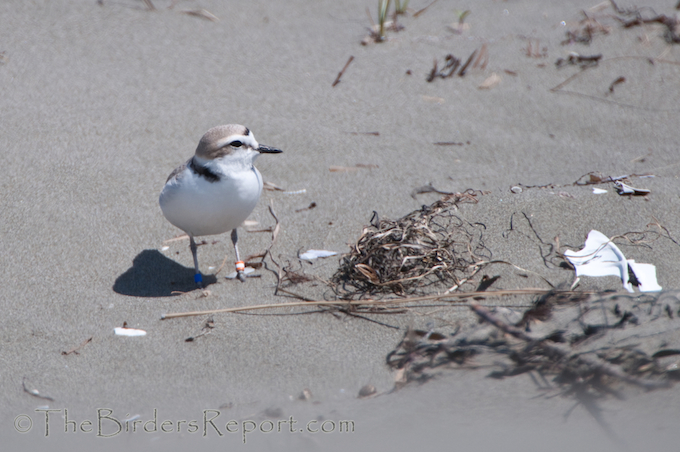

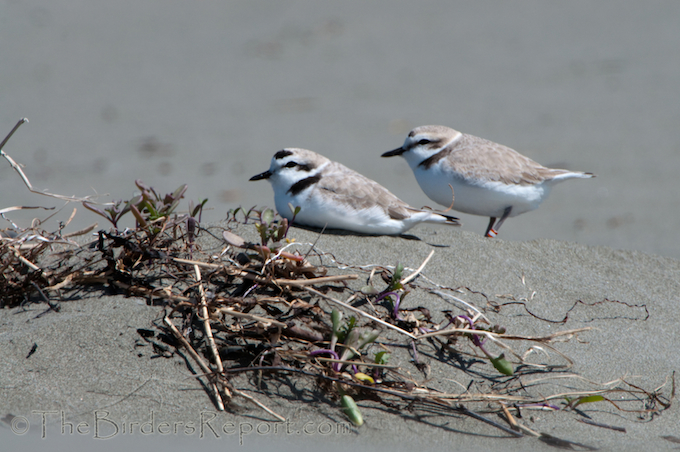
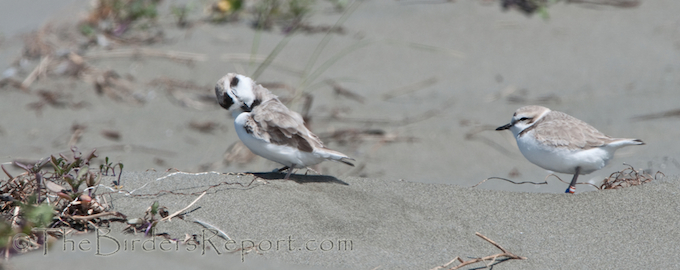
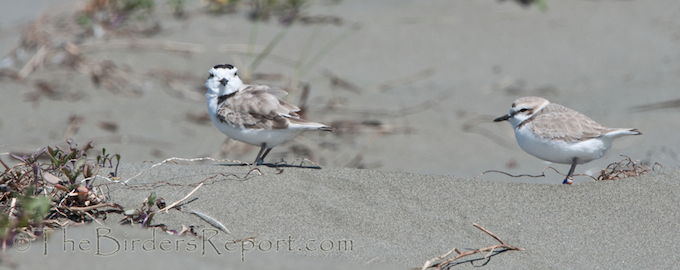








Comments on this entry are closed.
beautiful little birds.
I enjoyed your post and have a similar species with a similar problem that I posted today.
Lovely photos, interesting Reading. Well done!
We have also a lot of problems with invasive species, people that don’t understand nature but trample in fragile ecosystems and the lose of habitats. Thanks for this intersting post and the birds. I hope they survive.
Aren’t they swell? I’d love to see one in the ‘wild’…but I’ll have to settle with your photos. Which are fantastic by the way.
I was just here a few minutes ago in my Hootin’ Anni blog admin and went over to I’d Rather B Birdin’ and saw your link. Thanks for this post—-I’m gonna have to make a trip to the beach and see what kind of plovers I can find in our area. There is one in particular that I’d love to find. So, I best get a move on.
Cute shots of your Snowy Plover. I see the Piping Plover here but I would love to see this cute bird too. Great post, I hope their dune habitats stay protected.
Love the images and the information you provided Larry!
a beautiful little shore- bird Larry and wonderful photos of
It’s always a treat to see an elusive bird. Wonderful shots! These two make a very handsome pair.
Beautiful muted colours!! Boom & Gary of the Vermilon River, Canada.
Great article! I was lucky to see the Western Snowy Plovers at the protected area of Oceano Dunes. They won my heart right away! Hope they are having a good breeding season this year, and hope folks will be responsible & keep their dogs on leashes in the protected areas!
Great photos and information about the Snowy Plovers, Larry!
Great article, Larry! Superb photos of a species I hope to see one day.
Cute little birds.
Amazing bird and thank you for sharing the interesting information! I’m thrilled to see the banded birds and you captured some amazingly touching moments as well. NICE all the way around!
These are such tiny and vulnerable birds, you’d think more could be done to educate the hapless public of their existence as well as the fact that they need to be protected. Humans in general seem to be content to blissfully carry on without thinking of the world around them.
Thank you for caring, and sharing these wonderful photos. I appreciate that you went to great lengths to find these amazing birds!
Grandma Pearl
Great photos.
We saw the Snowy Plovers breeding in Florida this year. It’s somehow incredible that they breed just next to the people enjoying the beach…